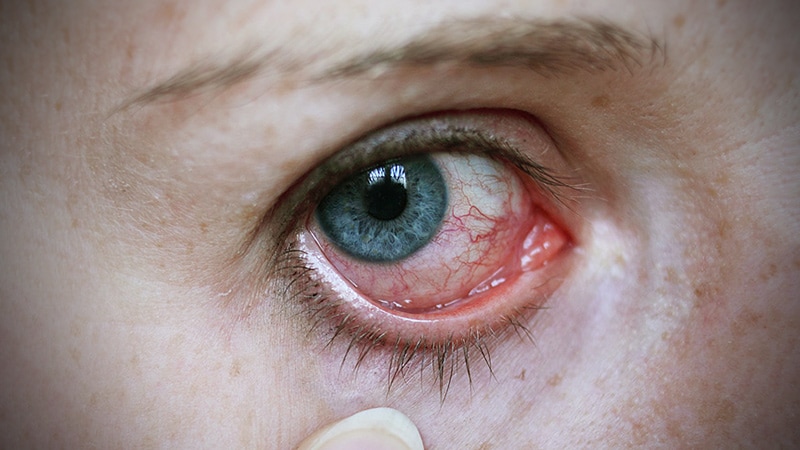Symptoms of dry eye correlated with depression in one of the largest studies to examine the relationship.
Clinicians should take the relationship into consideration when treating either condition, said Gui-shuang Ying, PhD, a professor of ophthalmology at the University of Pennsylvania in Philadelphia.
“I would say that if the patient sees a doctor for dry eye, the doctor should check with the patient to see if they have depression,” he told Medscape Medical News. “And if the patient has psychological symptoms of depression, the doctor should check for symptoms of dry eye.”
Ying and colleagues published the findings March 10 in JAMA Ophthalmology.
Multiple previous studies have identified an association between depression and dry eye disease, but these have mostly been single-center, cross-sectional studies. Ying and colleagues took the opportunity to explore the association more deeply by analyzing data from a multicenter clinical trial of omega-3 fatty acid as a treatment for dry eye disease that also collected data on depression.
In the DREAM study, people with dry eyes who took omega-3 fatty acid supplements did not have any better improvement than people who took olive oil placebos.
The study enrolled 535 participants between October 2014 and July 2016 from 27 clinical centers in 17 states. Patients had dry eye symptoms for at least 6 months, used artificial tears at least twice a day for 2 weeks before screening, and had Ocular Surface Disease Index (OSDI) scores of 21-80 at baseline.
The patients’ mean age was 58 years, 81% were women, and 74.4% were White. At baseline, 15.7% had depression, defined as a score of 42 or lower on the Mental Component Summary (MCS).
The correlation between lower MCS scores (indicating more severe depression) and higher OSDI scores (indicating more severe DED symptoms) was statistically significant at baseline (Spearman ρ = −0.09, P = .03), 6 months (ρ = −0.20, P < .001), and 12 months (ρ = −0.21, P < .001). The change in these two scores was not correlated, however.
MCS score did not correlate with any dry eye disease signs at any of these time points. But at 6 months, an improvement in MCS score from baseline correlated with an improvement in tear osmolarity (ρ = −0.11, P = .03), and with an improvement in composite severity score of DED signs (ρ = −0.10, P = .03). At 12 months an improvement in MCS score from baseline correlated with an improvement in the Schirmer test (ρ = 0.09, P = .04).
Previous research has suggested that inflammation could be the mechanism driving the correlation between dry eye disease and depression. But the researchers in this study found no consistent difference in inflammatory markers such as HLA-DR and cytokines measured in the tear film of participants with and without depression, though there were some correlations to individual markers at certain timepoints.
“This is a limited finding, because our inflammation biomarkers are from the tears, and not from blood,” Ying said. “Some might argue that inflammation biomarkers in the blood are more important.”
The researchers also did not find an association between the use of antidepressants and more severe dry-eye disease symptoms or signs. This finding undercut a previous theory that antidepressants might explain how dry eye disease and depression are related.
The study makes a significant contribution to the understanding of the relationship of dry eye and depression because it is so large, and because it looked at the way the relationship changed over time, said Anat Galor, MD, MSPH, a professor of ophthalmology at the University of Miami in Miami, Florida, who wrote an accompanying editorial on the study.
“The main punchline of this study was that depression relates more closely to dry eye symptoms than dry eye signs,” she told Medscape Medical News. And even the correlation between dry eye symptoms and depression was weak, she said.
“So it means that depression and dry [eye] symptoms are correlated, but that they don’t completely explain one another. Is it that depression leads to dry eye symptoms, that dry eye symptoms lead to depression, or that there is some underlying confounder that is driving the association?”
The data on medication use and inflammatory markers was also helpful, she added.
She would like to see follow-up studies that examine the many subtypes of dry eye disease to tease out whether there is a closer correlation to one or more of them that might better explain the findings so far.
Although antidepressants did not correlate with dry eye disease in this study, clinicians should be aware that anticholinergics in particular can reduce tear production, said Alvin Young, MMedSc, a professor of ophthalmology and visual sciences at the Chinese University of Hong Kong, who was not involved in the study.
He noted a key limitation in the study: that participants who provided sufficient tear samples were younger and had less severe symptoms and signs than participants who could not provide sufficient tear samples. This could explain why the study did not establish a role of inflammation, he told Medscape Medical News. “That’s probably skewing the results a little bit.”
The study was supported by the US National Institutes of Health. Young, Galor, and Ying have disclosed no relevant financial relationships.
JAMA Ophthalmol. Published online March 10, 2022. Abstract, Editorial
Laird Harrison writes about science, health and culture. His work has appeared in national magazines, in newspapers, on public radio and on websites. He is at work on a novel about alternate realities in physics. Harrison teaches writing at the Writers Grotto. Visit him at www. lairdharrison.com or follow him on Twitter: @LairdH
For more news, follow Medscape on Facebook, Twitter, Instagram, YouTube, and LinkedIn
Source: Read Full Article
